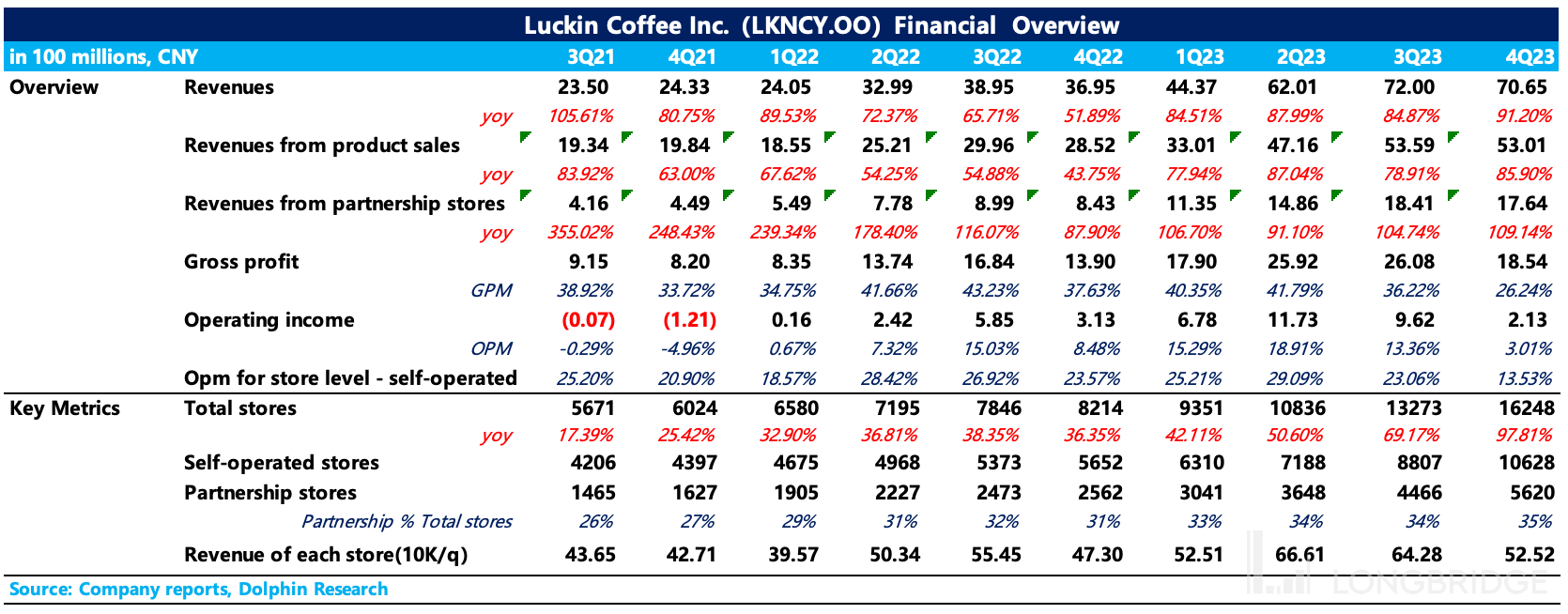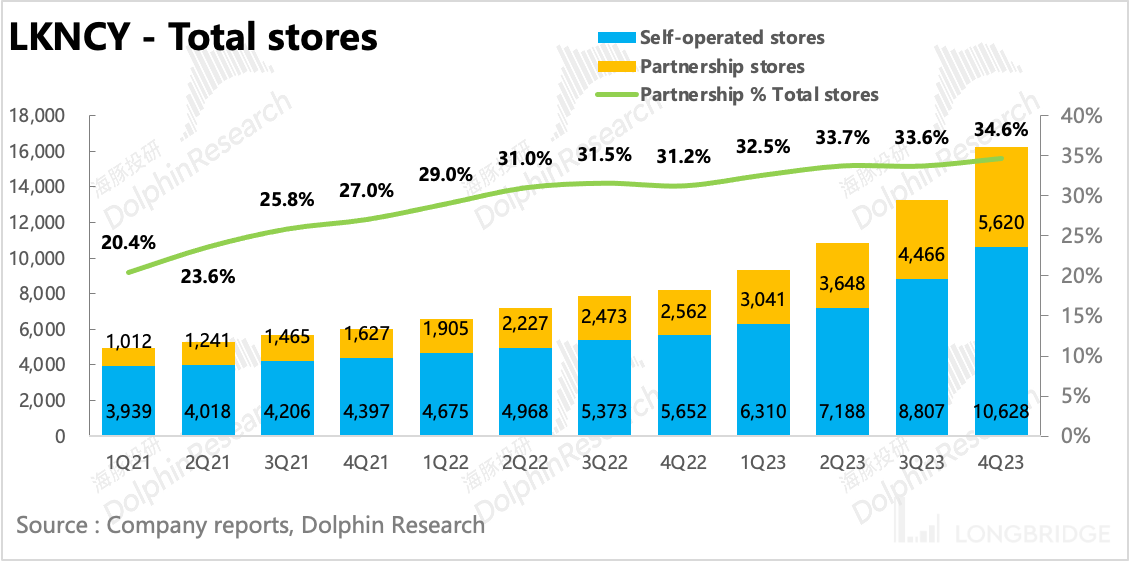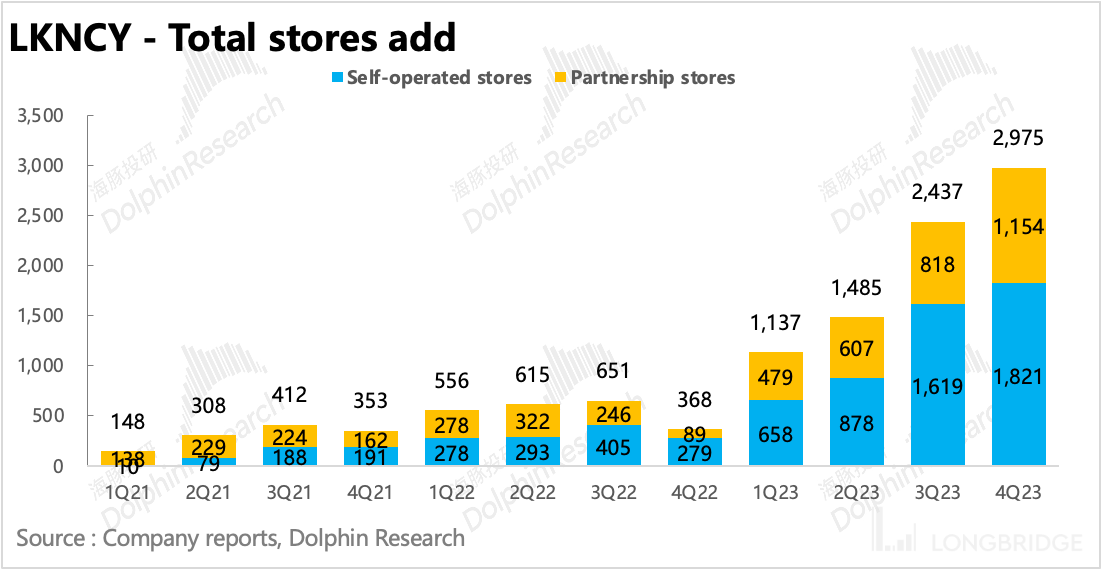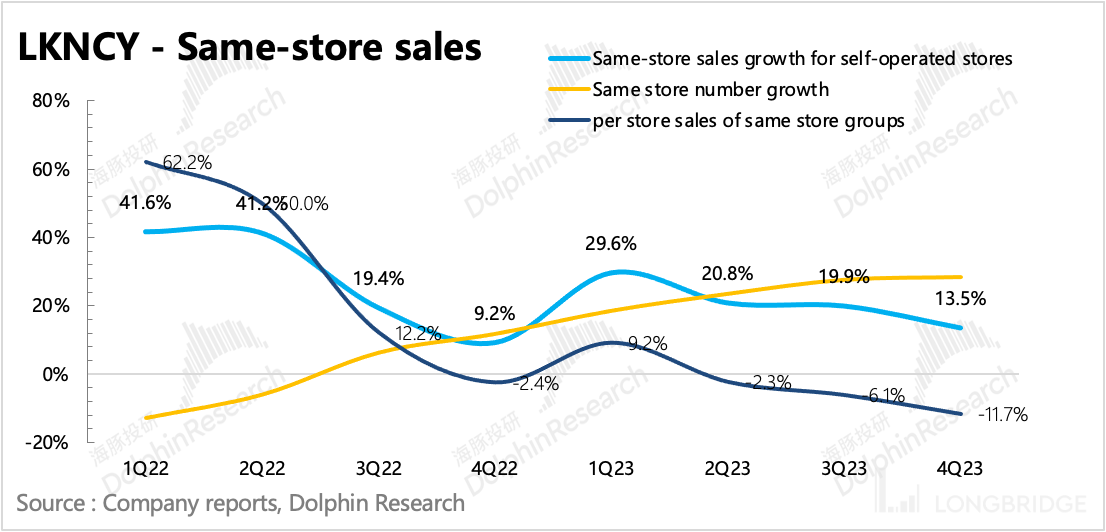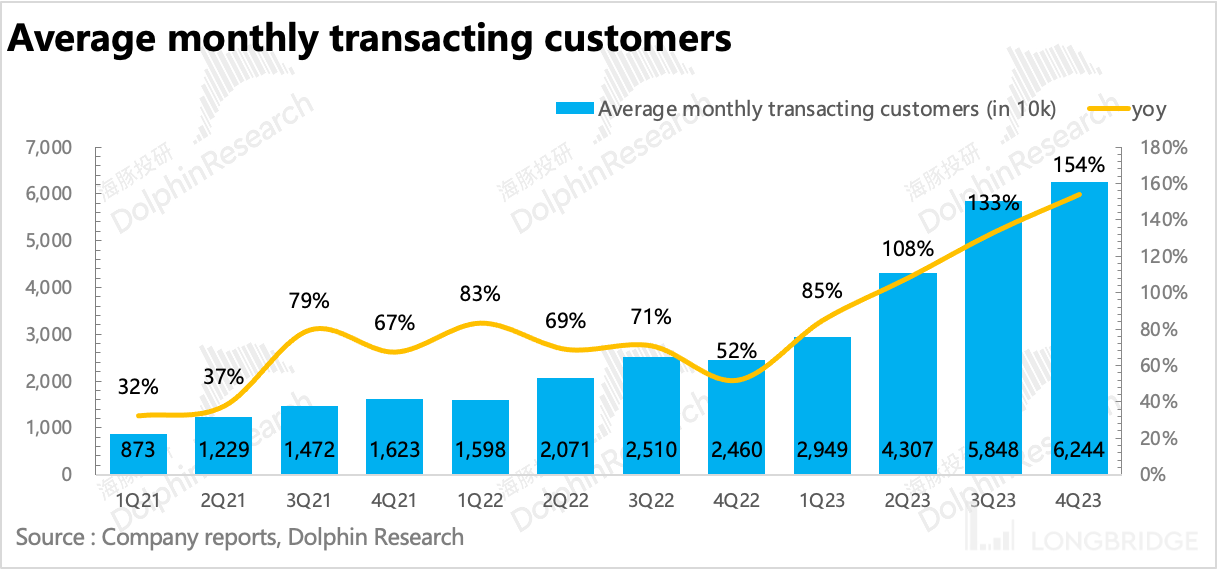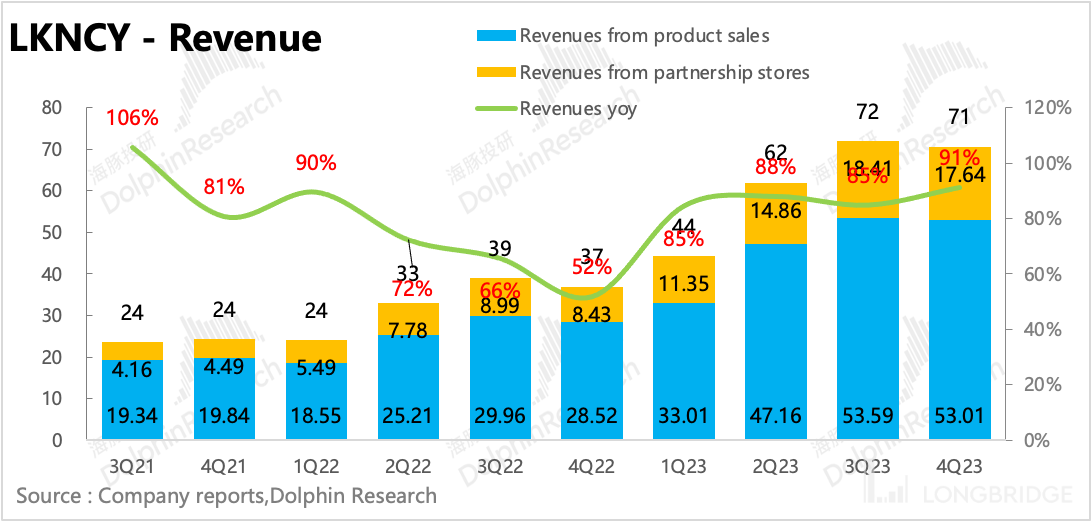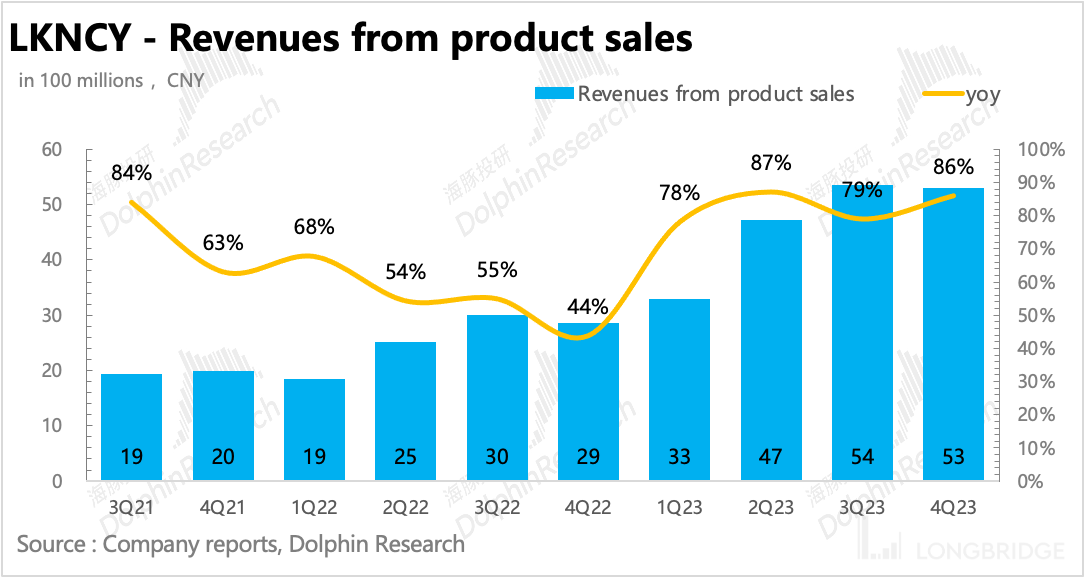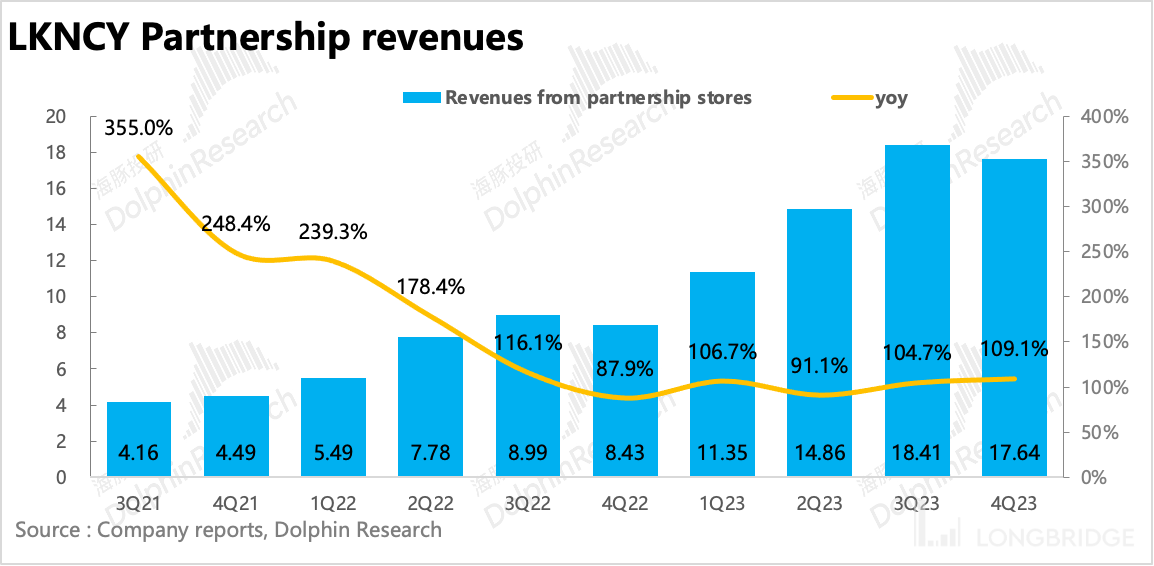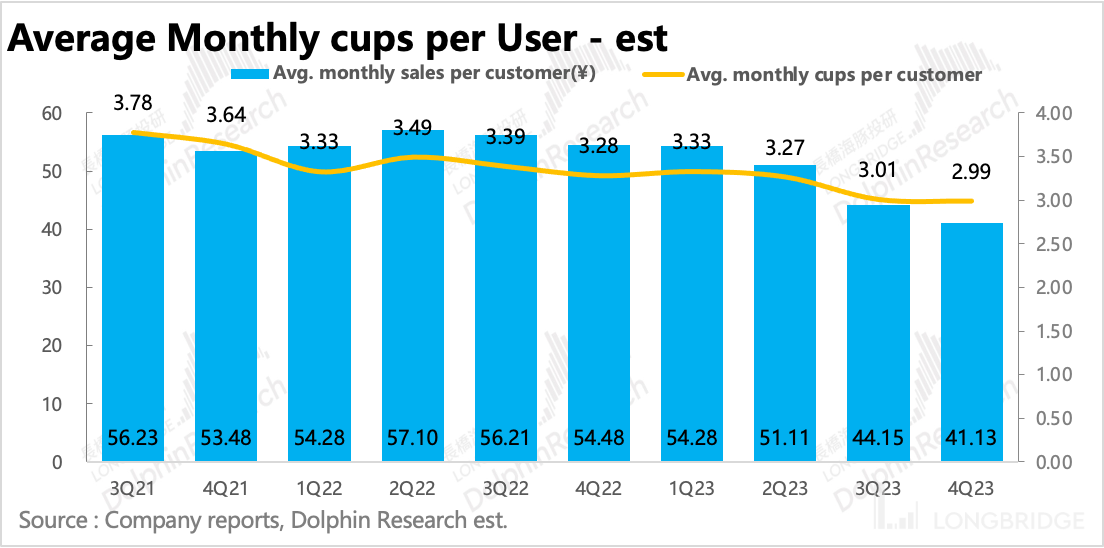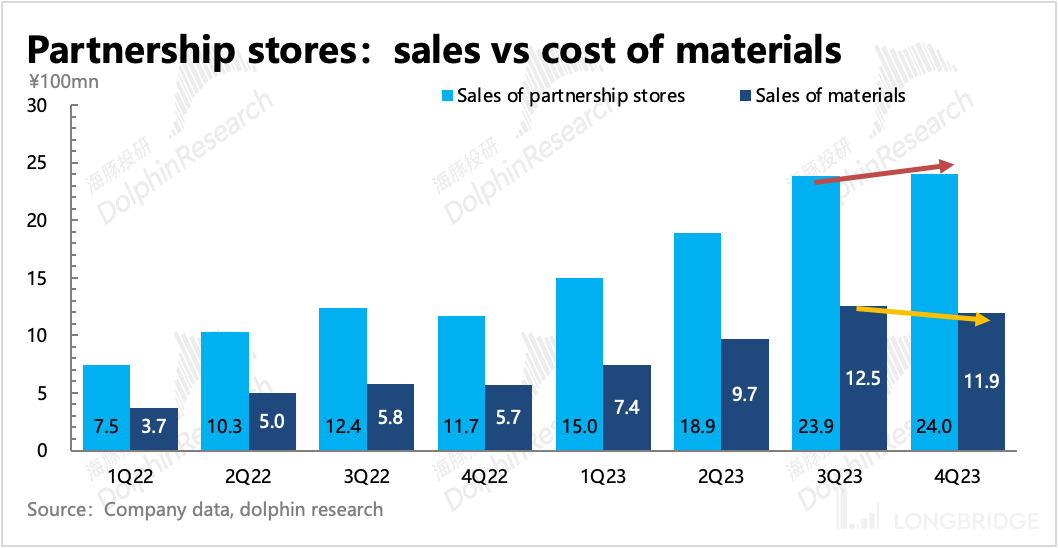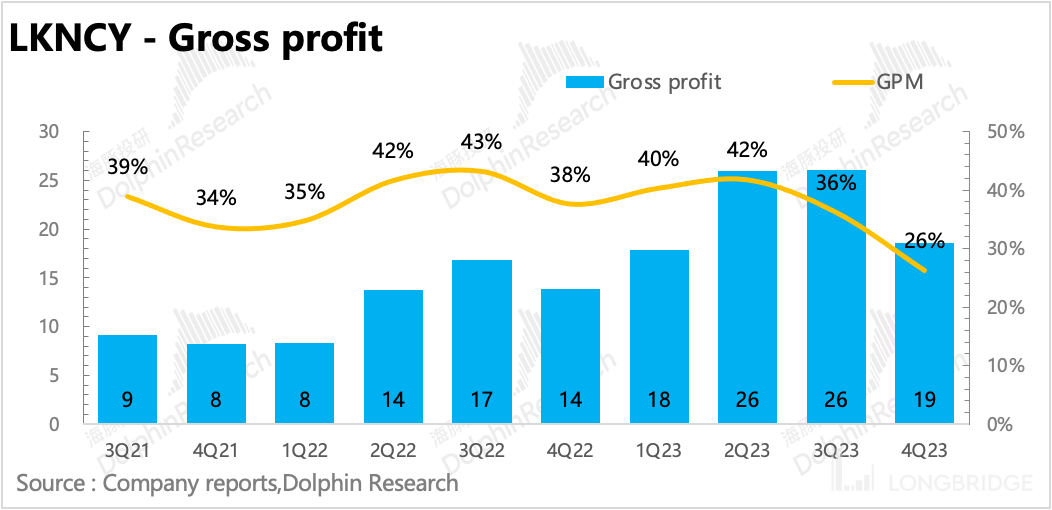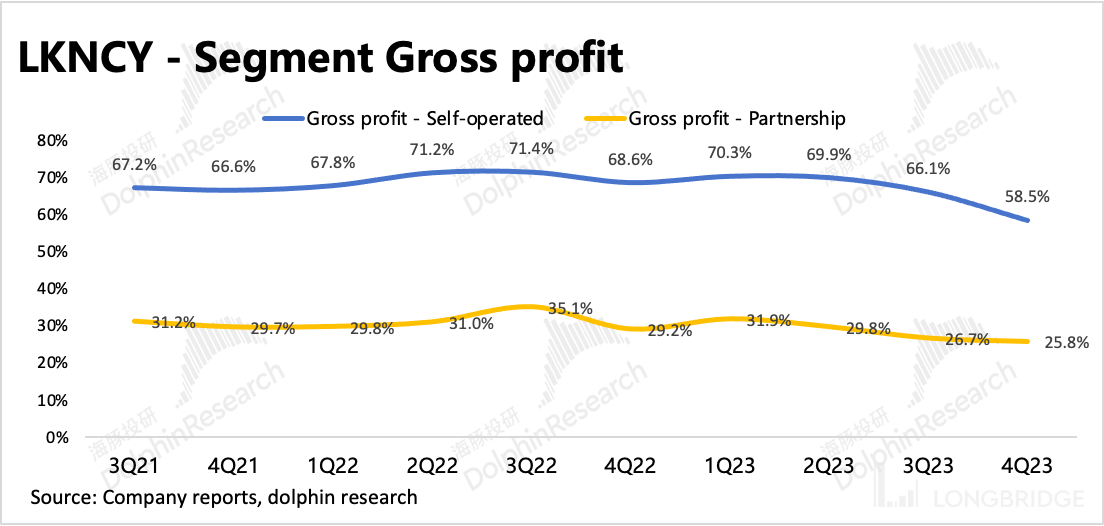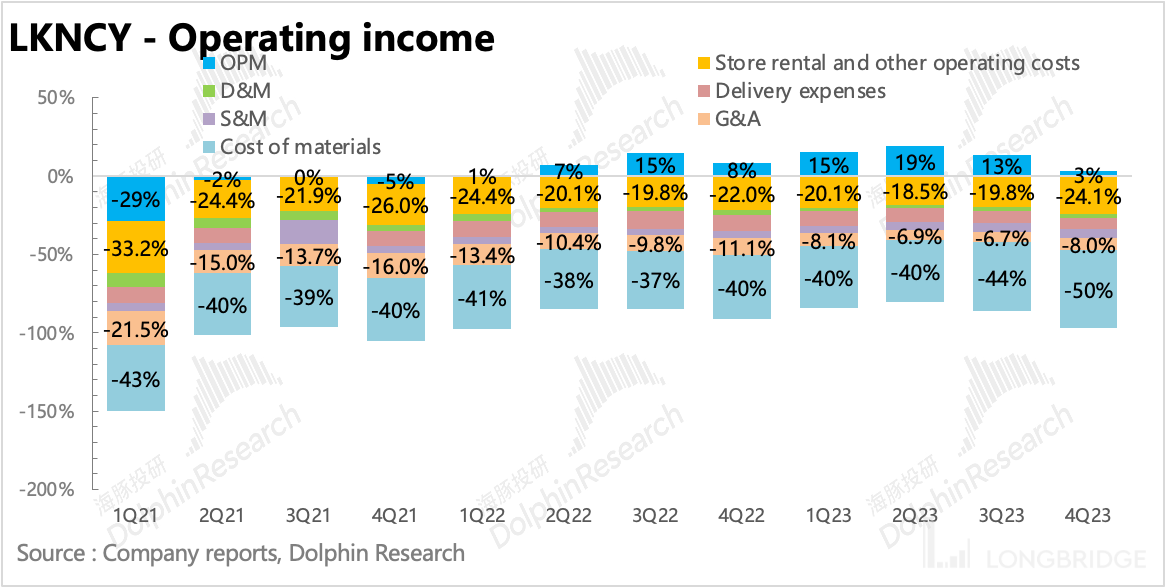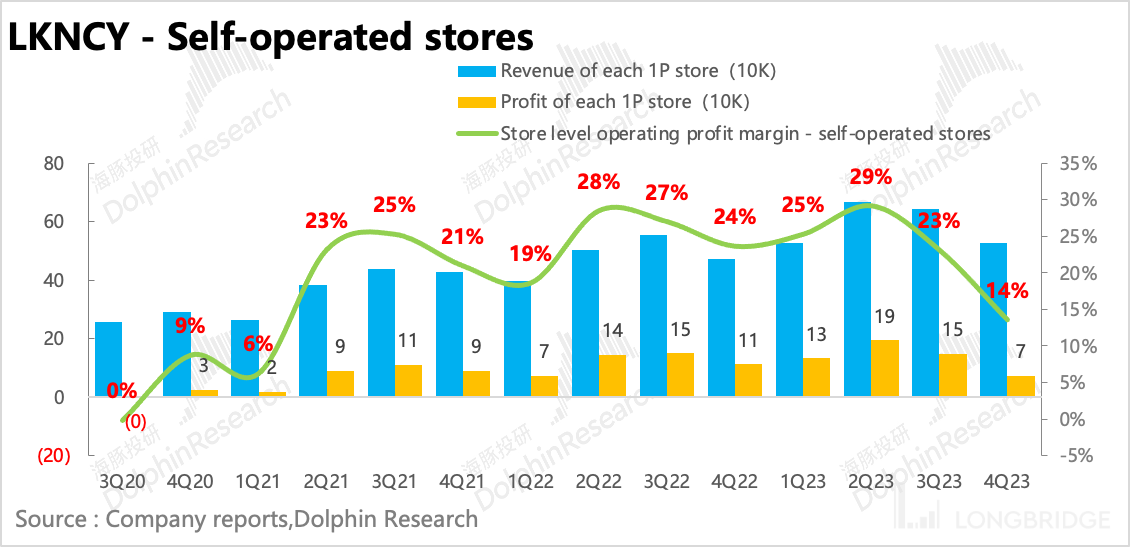Luckin Coffee: The Darkest Before Dawn
On the evening of February 23, Beijing time, before the US stock market, Luckin Coffee.US (LKNCY.OO) announced its financial results for the fourth quarter of 2023.
The lackluster performance of the fourth quarter has finally been revealed. The revenue of 7.1 billion is basically in line with expectations, but the final net profit is only 300 million, lower than the market's expectation of around 400 million.
Off-season (low demand, high costs) + 9.9 price war + rapid store expansion (the accelerated opening of stores in the fourth quarter) have led to a profit margin of only 13.5% at the operational level of self-operated stores, far below the normal level of around 25%.
Luckin Coffee's repeated doubling of "compassionate subsidies" to franchisees has also resulted in lower income for franchisees than they should have received. Based on the difference between the indicators confirmed by the company and the raw material costs in the financial report (raw material income), compared to the normal quarterly gross profit margin level, Luckin Coffee provided franchisees with subsidies of 3-4 billion in the fourth quarter (not the actual value, for reference only).
In the short term, the fourth quarter is a stress test under relatively extreme conditions. What needs to be watched next is the company's guidance for the first quarter, which represents whether there will be a new round of stress testing.
However, there are already signs of dawn in the information outside the financial report: According to research information, since January, there has been some relaxation in the price war between Luckin Coffee and KFC, with a certain increase in the average price per cup, but the cup volume is still declining compared to the previous period. How much of this is due to reduced subsidies and how much is due to seasonal factors such as the winter holiday and the Spring Festival return home effect still requires more information from the management during the conference call.
In the medium to long term, looking at the number of users, the monthly transaction volume of a single store is still showing high growth, indicating that there is still room for user penetration. In the long term, cultivating the coffee habits of these users will be the main source of growth after a significant slowdown in store openings.
The key points of this financial report are as follows:
1. Continued acceleration of store openings: The number of stores is the most intuitive indicator of Luckin Coffee's growth status and has been a key metric of market concern for over two years. By the end of the fourth quarter, the total number of stores reached 16,200, with a net increase of 2,975 stores compared to the previous quarter, and both self-operated and franchised store expansions are still accelerating.
2. Decrease in both store volume and price per store: In the fourth quarter, the expected decline in daily average store volume and cup price (ASP) in the single-store model.
The maintenance of the 9.9 yuan promotion and the decline in sales of high ASP products like Narui Ice and Sauce Maotai have caused a decrease in ASP, which was largely within expectations.
Decline in Cup Volume: Due to the off-season and reduced purchasing desire of customers, cup volume has been significantly impacted. Based on our research data, we have calculated a 13% MoM decrease in cup volume, slightly better than the industry average (-20% to -15%).
Slowing Growth in Same-Store Sales: The growth rate of same-store sales in the fourth quarter has slowed to 13.5%. Despite a significant increase of 28.5% in the number of existing stores, the average revenue decline per individual store (operating for over 1 year) has widened from 6% in the previous quarter to 12% (this figure is conservative, and considering the impact of store closures, the actual decline per store has slightly eased).
The operational situation reflected by the same-store sales growth of individual stores was discussed in detail in our previous quarter's financial report. However, in other words, Luckin Coffee stubbornly accelerated store openings in the off-season and under high competitive pressure, inevitably leading to an expansion of revenue decline per store.
New User Coffee Habits: There are multiple reasons contributing to the decline in same-store sales per store. Does this imply that the ceiling has been reached? Dolphin Research believes not entirely. In the current period, the cultivation speed of users' coffee habits is slower than the speed of store openings.
Combining the number of users and average cup volume, the transaction users in the fourth quarter reached 62.44 million, mainly driven by new store openings. The number of paying users per average store also increased by 38% YoY, indicating that Luckin Coffee is steadily penetrating the coffee market.
Although the coffee market still has significant long-term potential, the average monthly coffee cup purchases per capita have been declining YoY since the second quarter, indicating a significant difference in coffee consumption frequency between new market expansion users and existing customers.
However, coffee has a mild addictive nature, so gradually increasing the frequency for new users in the long term is not a major issue. The MoM decline in the average monthly cup purchases per capita in the fourth quarter has slightly eased, which is a positive sign worth further observation.
Profit Pressure Test: The company only achieved an operating profit of 213 million in the fourth quarter, with a profit margin as low as 3%, reverting to the level of two years ago. However, due to the exceptional circumstances and a multitude of unfavorable factors, this can be considered a stress test for the company's profitability.
Both quantity and price reductions have squeezed the self-operated revenue, while the cost of hot drinks in winter has increased, significantly reducing the profit margin of self-operated stores to 13.5%, well below the normal 25% in a regular year. Additionally, in order to alleviate the pressure on franchisees, Luckin Coffee's increased subsidies to franchisees have also affected the raw material sales revenue in franchise income.
Therefore, the main impact lies in the gross profit margin. The growth rate of operating expenses basically follows the revenue changes, indicating that the company's basic operational efficiency is still intact. The erosion of profit margin by short-term cost fluctuations is not significant. Overall View of Dolphin Research:
Since the fourth quarter, the visible decline in cup volume and the decrease in customer unit price reflect the issues of competition and market ceiling. At the beginning of the year, Dolphin Research detailed the competition evolution between Luckin Coffee and KFC in the article "** 站不稳的库迪,卷不死的 Luckin Coffee**", discussing the impact of seasonal factors on the performance of the next 1-2 quarters. At the same time, from the perspective of franchisee investment payback period, a rough estimate of the mid-term store scale ceiling was made (in the long term, with the increase in coffee consumption penetration among Chinese users, there is hope to further break through the scale).
In the short term, the three main reasons for profit pressure in the fourth quarter are off-season + price war (including subsidies) + accelerated store openings:
(1) After passing through the fourth quarter, the intensity of the price war has eased marginally, and the 9.9 yuan promotion by both sides has narrowed.
(2) Secondly, the impact of the off-season will naturally decrease as the temperature warms up, and if the next explosive product is launched, the recovery can be accelerated.
(3) Although the speed of store openings has not slowed down in the fourth quarter, based on our rough estimate of a mid-term ceiling of 23,000 stores, Luckin Coffee, with over 16,000 stores currently, slowing down store openings in the short to medium term will help optimize the single-store model of existing stores and improve profitability.
In the long term, the rapid penetration of coffee users in Luckin Coffee's single stores will still give us some more optimistic imagination, it's just a matter of the length of the cultivation period.
Based solely on the fourth-quarter performance, we have not yet seen clear signs of improvement. However, as we have judged before, from the perspective of marginal changes in operations, Dolphin Research believes that Luckin Coffee's darkest moment has passed. Considering the discount on the liquidity of the fan base (80%), $8 billion is still not too aggressive as a valuation expectation.
After this round of fierce battle, Luckin Coffee has proven that it still has some brand barriers and the ability to cope with competition. Although there may still be pressure on performance in the next quarter, market confidence in the valuation of Luckin Coffee may recover further.
The detailed analysis is as follows:
I. When the enemy comes, we will meet them head-on, blindly accelerating store openings
In the previous quarter, we saw the impact of diversion in same-store sales, as well as the urgent situation of weak demand in the off-season and intensified competition. Dolphin Research initially thought that Luckin Coffee might take a breather in the fourth quarter and slow down the pace of store openings, especially since there were less than 2,000 stores left to reach the annual store opening target by the end of the previous quarter.
However, in reality, there was a net addition of 2,975 new stores in the fourth quarter, more than 500 more than the 2,437 in the previous quarter, showing a headstrong acceleration. This also aligns with the management's strategic proposal: seizing the market as quickly as possible is the key. In the newly added nearly 3,000 stores, 1,821 are self-operated stores and 1,154 are franchise stores. Compared to the previous quarter, franchisee support has significantly increased.
So, will the pace of store openings continue to be this fast this year?
From the perspective of the franchisee's investment payback period, Dolphin Research believes that with the comprehensive defeat of Luckin Coffee, when the scale of stores reaches 230 billion, it will almost reach a plateau in the short to medium term ("Unstable Luckin, Indestructible Luckin Coffee"). The future expansion will depend on the improvement of users' coffee consumption habits and dependence.
The above two points can be roughly observed from the indicators of "same-store growth rate" and "average monthly paying users":
(1) In terms of same-store growth rate, the overall revenue growth rate of the same store has significantly slowed to 13.5%, while the same-store growth rate of a single store in the fourth quarter has decreased by 11.7% year-on-year, with a further widening decline. Although this indicator does not consider the closure of old stores, the number of closures in the accelerated store opening cycle should be relatively small. On the contrary, from the trend perspective, it is obvious that the rapid store opening in the short term has led to increased diversion, affecting the economic model of individual stores.
In such a situation, companies generally have the intention to slow down store openings or optimize the overall economic benefits of existing stores by opening and closing stores simultaneously.
(3) The net increase in average monthly paying users in the fourth quarter was 3.96 million, reaching 62.44 million, with a year-on-year growth rate of 154%, mainly driven by new stores. However, looking at the average number of transaction users per store, although the growth rate in the fourth quarter has declined compared to the previous quarter, there is still a high growth rate of 38%, indicating that there is still room for long-term penetration of Luckin Coffee's coffee users and further cultivation of consumption habits.
Second, high revenue growth: Seizing the market first
In the fourth quarter, Luckin Coffee's total revenue was 7.1 billion yuan, a year-on-year increase of 91%, with the low base dividend brought by the high incidence of the epidemic in the fourth quarter of 2022. However, the core still relies on the incremental growth brought by quickly occupying new markets and new users. When we look into the details, due to more aggressive expansion, the revenue growth from franchise stores is higher (+109%), while the revenue growth from self-operated stores is 86%. In order to better execute the strategy of rapid market positioning, Luckin Coffee not only implemented a new cooperative model with its self-owned stores starting from May, but also lowered the qualification and investment threshold for franchisees to facilitate more rapid participation.
However, due to the price war at 9.9 yuan, it means:
On one hand, it lowers the average price per cup in stores. Before cultivating consumer habits to a certain extent, the increase in consumption frequency (number of cups) is limited, thereby affecting the direct sales revenue of self-operated stores and reducing the potential profit sharing of franchise stores.
On the other hand, because additional subsidies are needed for franchisees, Luckin Coffee's revenue from raw material sales is also reduced as a result.
Generally speaking, if the unit price of raw materials sold to franchisees by Luckin Coffee remains unchanged and the loss rate also remains unchanged, then the revenue from raw material sales should change synchronously with the turnover of franchise stores.
However, in the fourth quarter, the directions of change for both were opposite. While the turnover of all franchise stores was higher than in the third quarter, the revenue from raw material sales to franchisees by Luckin Coffee was decreasing on a MoM basis.
Therefore, based on the normal gross profit margin of 30% for raw material sales, Dolphin Research attempted to restore it. Originally, there should have been 1.58 billion in revenue from raw material sales, but in reality, it was only 1.193 billion, with a difference of 380 million, which is basically equivalent to the scale of subsidies and discounts Luckin Coffee provided to franchisees.
Three, Three Cuts Slashing Profits
In the fourth quarter, the profit pressure on Luckin Coffee exceeded market expectations, with the operating profit margin decreasing by 10 percentage points MoM, which is basically caused by the decline in gross profit margin. Off-season + low prices + subsidies made profitability in the fourth quarter extremely challenging. (1)Revenue from self-operated stores: Squeezed between low income and high costs. Dealing with the competitive strategy of RMB 9.9 low prices and the seasonal decline in sales of high-priced Nari ice cream, as well as the declining popularity of Jiangxi Maotai, has led to a decrease in the ASP of individual products. At the same time, due to the rigid material costs that make up the majority (even higher per cup in hot drinks during winter), it naturally compresses the gross profit margin per product.
In addition, the off-season affects overall sales demand, causing other fixed costs at the store level and some cost expenses at the company's headquarters that cannot be covered by incremental revenue.
(2)Franchise business revenue: The more stores opened, the more subsidies offset the raw material revenue.
The above factors have led to an overall gross profit margin of only 26% in the fourth quarter, a 10% decrease from the previous quarter.
Due to Luckin Coffee's basic control over the terminal pricing of all stores, the impact of the low-price strategy is not only reflected in self-operated stores but also in franchise stores. However, franchise stores not only have Luckin Coffee's subsidies, but also relatively lower sales volume, so the impact of changes in material cost rates is slightly smaller.
According to Dolphin Research's calculations, the gross profit margin of self-operated stores in the fourth quarter was 58.5%, a 8% decrease from the previous quarter, and the gross profit margin of franchise stores was 25.8%, a 1% decrease from the previous quarter.
In terms of expenses, except for slightly higher marketing promotion expenses this quarter, other expenses basically change with revenue changes, essentially the costs brought by store expansion and headquarters expenses, with little overall optimization.
The revenue from self-operated stores accounts for 75%, so the profitability of individual stores and the overall profitability of the company have changed by about 10 percentage points.
Overall, the 3% operating profit margin in the fourth quarter can be seen as a kind of stress test under relatively extreme conditions. Therefore, the inevitable situation is that profitability will continue to recover with the loosening of price wars and the increase in user consumption frequency (short-term looking at explosive products, warming weather, long-term looking at the cultivation of user coffee consumption habits).
Therefore, this is also what we have repeatedly emphasized in "Unstable Luckin, Indomitable Luckin Coffee", although the market is very concerned about Luckin Coffee's short-term profit indicators, from the perspective of competition, At present, the focus is on scale (store openings, revenue/income), and user consumption stickiness (average purchase volume per person) is more important than profit. When the poor performance in the fourth quarter and first quarter is priced in by the market, it actually presents an opportunity due to overly pessimistic expectations.
Dolphin Research's "Luckin Coffee" Series Articles:
Earnings Season
- November 2, 2023 Earnings Call: "Broad Market, But Competition Far From Over (Luckin Coffee 3Q23 Earnings Call Summary)"
- November 1, 2023 Earnings Review: "Rapid Growth All the Way, How Many Good Days Are Left for Luckin Coffee?"
- August 3, 2023 Earnings Call: "Luckin Coffee: Constantly Launching New Products, Aggressively Expanding Stores, and Increasing Buyer Base (Summary)"
- August 3, 2023 Earnings Review: "Luckin Coffee's 'Ten Thousand Stores' Sprint, Dominance Firmly Grasped"
- May 2, 2023 Earnings Call: "Luckin Coffee: Anticipating Early Achievement of Ten Thousand Stores Goal"
- May 2, 2023 Earnings Review: "Luckin Coffee: Rapid Expansion of Stores, Full Recovery"
- March 3, 2023 Earnings Call: "Achieving Ten Thousand Stores Goal in 23 (Luckin Coffee Performance Meeting Summary)"
- March 2, 2023 Earnings Review: "[New Luckin Coffee 'Reborn from the Ashes']](https://longportapp.cn/en/topics/4337439)" In-depth Analysis
On January 16, 2024, "The Unstable Kudi, the Indestructible Luckin Coffee" was published.
On March 14, 2023, "Striking Down the Tumor, Luckin Coffee Wins the Redemption Battle" was released.
On February 14, 2023, "Luckin Coffee (Part 1): Taking Coffee to the Countryside, Can the Hype in Small Counties Last?" was published.
For risk disclosure and statements in this article: Dolphin Research Disclaimer and General Disclosure




